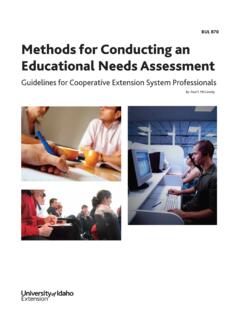Transcription of Methods Baseline Assessments Form
1 M&E Technical Advisory Notes Series Overview of Methods for Baseline Assessments Including template for TORs A Baseline assessment is a study that is conducted at the beginning of a project or a programme, in order to analyze the current food security situation. It gives a picture of the situation before the inception of the programme, and results can then be compared with a follow-up assessment towards the end of the programme, in order to understand the effects that the programme has had on the target population (ie. assess impact). An impact assessment should provide answers to two key questions: What changes have occurred in the participating population since the beginning of the programme. To what extent are these changes attributable to the programme. In order to answer these two questions, the design of the impact assessment should: Allow an adequate analysis of the situation before and after programme implementation.
2 Use a carefully selected control group to reflect the situation that would have been observed in programme participants had the programme not been implemented. This will involve the use of data to answer questions and arrive at conclusions. Therefore, planning for impact assessment - which ideally starts during programme development or early on during the inception phase - also involves deciding upon which Methods and approaches1 should be applied in order to get the required information. This technical note provides an overview of the various Methods and approaches that can be used for a Baseline (or follow up) assessment , taking into account the stakeholders information needs and the overall programme context. 1 An impact assessment method is a process that is carried out in a series of steps to obtain and analyze the needed information. An approach is the manner in which different Methods can be combined.
3 The M&E Technical Advisory Notes are developed by the FAO Integrated Food Security Support Service (TCSF) to support regional and country s efforts in M&E of Food Security Programmes. These tools are handy guides of a complete M&E tool-kit which is indented to complement the E-Learning Course on: Assessing Impact of Development Programmes on Food Security For further information: M&E Technical Advisory Note Overview of Methods for Baseline Assessments 1. Quantitative Methods Understanding the what , where and when Household surveys The most common way to use a quantitative method for assessing food security is through a household survey. Household surveys are extremely useful when data must be collected first-hand for the explicit purpose of the Baseline assessment . Survey questions are used to create pre-determined impact indicators. The same questions are asked before the programme begins (at Baseline ) and again after it has been implemented (follow-up).
4 Comparison of indicator levels before and after will provide quantitative evidence of change since the beginning of the programme. Carrying out a household survey requires taking various steps, that are briefly described below: Defining the sampling method Household surveys gather information from a sample of households in order to draw conclusions about the population that the sample represents. Information gathered from the sample can be generalized to the entire population of interest when the sampling method is appropriately chosen and properly executed. Defining the sampling method means determining the: Sampling unit: in general, for household surveys, the sampling unit is the household. In some cases, it may also be the individual. This depends on the kind of information to be collected. Sample frame: for a Baseline survey, the sampling frame will usually be composed of the population targeted by the project ( all smallholders in a given area) and a control population ( all smallholders in a neighboring area where the project will not be present).
5 Sample size: this is the number of households that will be interviewed for the survey. The size of the sample will depend on a number of variables that should be well defined prior to the survey. Sampling approach: how will the households be selected? One may opt for a simple random sampling, a cluster sampling or a stratified sampling. The choice will depend on the resources and time available, and the characteristics of the population of interest. Once all these elements are clear, the list of households constituting the sample can be drawn. This is where the enumerators will conduct interviews. Developing and testing the questionnaire Surveys are typically administered through a questionnaire, which is made up of standardized, mostly close-ended, questions. Before conducting a quantitative survey, it is necessary to develop and test the questionnaire that will be used to gather information. The typical food security Baseline questionnaire is comprised of a few different categories of information, each one serving a particular purpose: Identifiers ( geographic area, household ID number, date of interview) Background Characteristics (factors by which participants and controls may differ, which could bias the ability to measure impact.)
6 Socio-economic status, participation in other projects/programmes, livelihoods, educational level etc.) Indicators for disaggregating data ( by gender, by level and type of programme participation) Outcome indicators (measures of what the programme intends to change in order to achieve food security, farming practices, or wealth levels) Impact indicators (measures of food security programmes achievements, dietary diversity, stunting prevalence) Once the draft questionnaire has been developed, the questionnaire should be pre-tested to ensure that: - questions are complete and accurate - response options are relevant and as exhaustive as possible - respondents comprehend what is being asked of them. Enumerators recruitment and training In order to ensure quality of the data, it is recommended to: Hire professionally trained and experienced enumerators. Conduct centralized training for all enumerator teams to ensure standardization in survey administration.
7 Incorporate a field test of the questionnaires during the training to vet enumerators and to allow them to practice and receive feedback before beginning the survey. M&E Technical Advisory Note Overview of Methods for Baseline Assessments Secondary data While a properly conducted survey is an extremely powerful tool for assessing impact, it is also one of the most costly and difficult Methods . In some cases, good quality data may have already been gathered by others for a different purpose (secondary data), and can be re-utilized for the Baseline assessment . This option should be considered in particular when limited financial resources or time are an issue for the programme. It may indeed be less expensive to hire an experienced assessor or statistician to identify data sources and carry out an appropriate data analysis, rather than conduct a survey to collect primary data. This will most probably involve a re-analysis of raw secondary data in order to construct pertinent food security impact indicators, and to create a Baseline or an appropriate control group.
8 It is common for quantitative impact Assessments to make use of a combination of primary and secondary data. 2. Qualitative Methods Answering the why and how Qualitative Methods are effective in understanding the process that caused the change. They gather information about the values, opinions, behaviors, and socio-cultural context of particular populations from their own perspective. The advantage of qualitative Methods is that they usually provide a much stronger context and the results can more easily be communicated. Drawbacks are that the findings may not easily be generalized to a larger population and they may be biased if the assessment is not carried out by skilled facilitators. Design The design of qualitative impact Assessments follows the following key steps: Sampling Qualitative Assessments do not normally use probabilistic sampling. Their strength lies in delving deeply and clarifying issues, rather than in covering large numbers of people with a view to develop generalizations.
9 Purposive sampling is commonly used to focus the assessment on the people and issues of interest. Samples are often stratified by different groups of people from different geographic locations, socio-economic groups, or from within households. Because the probing done through qualitative techniques can be time consuming, the size of the sample is very often determined by: the heterogeneity of the community (how many different groups need to be interviewed to generate a sufficient level of insight) time constraints (of both the assessor and the participants) resource constraints (number of moderators and/or facilitators available). Structuring the assessment Similarly to quantitative surveys, the assessment team will have to decide on how to structure the qualitative assessment . In particular, decisions should be made about: the techniques that are most appropriate for answering the different questions (see Annex 1 for a description of various qualitative techniques) how to sequence the different techniques, in view of the need to select participants for specific exercises based on the results of another exercise the level of participation that is required or desirable and how to manage the expectations that people s participation may bring about.
10 Once a decision has been made on the most appropriate mix and sequence of techniques, guidance sheets need to be prepared to: - explain in detail the specific purpose of each technique - describe how the technique is to be carried out - provide a list of interview or discussion questions - explain how to document the findings - outline the required materials, skills, time, etc. Planning for survey quality Principles of quality control apply to qualitative Assessments as well as to quantitative surveys. A qualitative assessment should not be thought of as an assessment instrument to be carried out rapidly, cheaply, without much preparation, and with inexperienced facilitators. Good qualitative Assessments , especially those involving high levels of participation, take time, skills and resources. In order to optimize the quality of the results, it is important to ensure that local elites or other groups do not manipulate the assessment to serve their own specific purposes, and that the assessment does not create expectations that could bias the answers.















